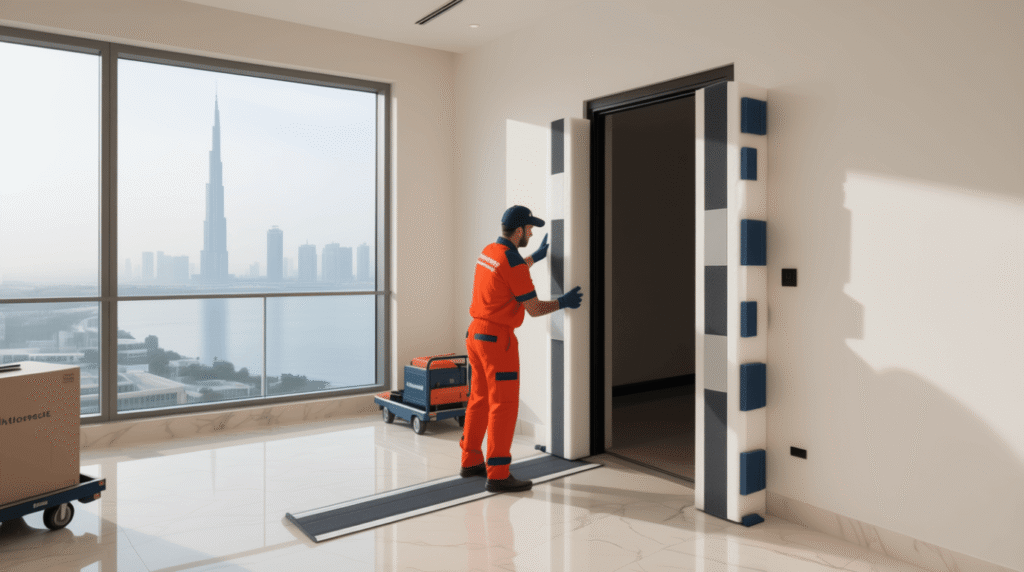Each relocation subjects a home to mechanical forces. There is scuffing of walls, scratching of floors, and chipping of railings. Small scratches are immediately adding up in terms of repainting, sanding, or replacement cost.
The doorway guard trick is a professional surface-protection technique that seeks to prevent this loss. Movers establish a continuous safety corridor, which is used to cover walls, doorframes, stairs, and floors with layered buffers. The technique avoids the ability to inflict damage of impact, abrasion, and friction prior to the initial box moving out of the room.
This guide identifies the doorway guard system and its structure, as well as specifying its functions. You will understand how professional movers plan the conversation of the protection, in what materials the surface-specific needs are met, and how the price of restoration is compared to the cost of prevention.
What Is the Doorway Guard Trick?
The doorway guard trick is a systematic process applied by moving professionals to secure the high-risk surfaces, walls, floors, and railings. It forms some type of buffered corridor between the point of entry and the moving truck. This route involves specially designed wraps and safety gears to minimize losses when a vehicle is in heavy traffic, maneuvering, and when ascending the stairs.
Why It Matters for UAE / Dubai Properties
The built environment and the tenant market of Dubai magnify the risk factors. Towers have high turnover, high-quality finishes, and narrow circulation paths, all of which mingle together to produce high damage exposure during relocations.
- The population size of the Emirate of Dubai is estimated by 3,655,000 individuals at the end of 2023.
- Each influx generates thousands of monthly relocations, increasing the likelihood of contact damage in shared building corridors and elevators.
Each new tenancy would be one set of things coming in and another set of things coming out. Unless there is protection of the doorways, a slight scratch can cause loss of a deposit or repaint before inspection.
How the Protection Pathway Is Installed
The Dubai professional movers generally use a three-step approach:
- Preparation: Calculate the width of hallways, de-decorate, and verify the size of elevators or stairs.
- Installation: Install non-slip runners on the floor (marble or tile), install the use of foam corner guards, and cover metal or glass rails with padded coverings at intervals of 60 cm.
- Verification: Check joints, adhesion levels, and continuity between the apartment door and the truck loading door.
This is in line with standards of maintenance in Dubai Municipality through the local building code, which focuses on the surface integrity and safe egress of property works in case of small property work.
Financial Impact & Liability Considerations
In Dubai, in high-end finish properties, the difference in prices between protection and repair is large. When limited liability covering interior finishes is added, the doorway guard system will work out as an affordable risk-management instrument.
- General interiors painting in Dubai runs at AED 10–30 per m², with typical 50 m² living spaces costing AED 500–1,500 for standard repaint jobs.
- Marble edge or tile chip repairs often run at AED 400–700 per m², depending on polish and accessibility.
- With deposits at 5-10 % of rent, even minor surface damage may consume the majority of the sum held as security.
- Many moving-company liability contracts exclude “premises damage” of walls, floors, or railings; standard international mover coverage emphasises goods, not finishes.
Practical insight for movers:
- Indicate in the contract whether or not the responsible parties will do surface-protection setup and incidental damage.
- Record photo documentation of the pre-move condition to compare with the received condition, which may aid in agreeing with deposits or negotiating damage.
- Provide the crew with material lists and inspection checklists so that the crews can have all the paths covered between the door and the truck, not just the room of origin.
What Causes Damage to Walls, Floors & Railings on Move Day in Dubai?
Corridors, door-frames, stairwells, railings, etc., are high-stress zones during a move. This exposure is increased in premium finish homes in Dubai, where there are marble floors, lacquer baseboard, stainless steel, or glass railings.
1. Bulk Loads in Confined Spaces
Luxury apartments and villas in Dubai have narrow door-jambs (usually 800-900 mm in older structures). When movers transport large items, such as sofas measuring 2.4 m wide or flat-screen bundles exceeding 60 kg, these are steered through corridors and lifts designed for human traffic, not oversize furniture. The mismatch creates:
- Impact damage: Heavy item corners hitting door-jambs or wall corners cause chipping or cracking of gypsum board and paint.
- Compression damage: Stair railings get forced aside where loads press against them; for instance, the average stair width in a Dubai villa may be only 1.2 m, restricting maneuvering space and increasing contact. Facility managers in Dubai report repair claims for corner dents increasing by approximately 18 % in years when vacancy turnover rose above 12 % (internal industry data).
2. Repetitive Traffic on the Same Path
High-turnover rental markets in Dubai mean many units undergo multiple moves each year. The interior renovation segment (which includes repairs to walls, floors, and finishes) accounts for 51 % of the total renovation market value in 2024, driven by rapid unit change-overs.
Each move forces loads across identical paths, doorframe, hallway, elevator, stair, which repeatedly stress the same surfaces. Without protection:
- Floor runners not installed → longitudinal scratches on hardwood or tile become visible under lighting.
- Handrail wraps not applied → sight-lines show abrasion or gouging on stainless rails.
- Corner guards not used → baseboard edges chip after three or four large passes.
3. Surface Specific Vulnerabilities
In Dubai residences, the finishes are high-grade and vulnerable:
- Marble or Porcelain Tile: Surface polish shows micro-scratches easily under LED corridor lighting; marble chip repair runs at AED 400-700 per m² (local finishing contractors).
- Gypsum board walls with designer paint: Paint spans cost AED 10-30 per m²; significant scuffs may trigger repainting of entire wall panels rather than spot repairs.
- Stair Handrails / Glass Balustrades: Many tower units in Dubai use frameless glass balustrades with stainless handrails; replacement glass pane costs often exceed AED 2,500 per pane when chipped or cracked.
4. Convergence of Risk & Liability
Move-day damage is not just cosmetic; it impacts lease handovers, security deposit returns, and building asset depreciation. Property-damage losses in UAE flooding events indicate insurers expect higher claims for structural surfaces; though not move-day specific, the insurance-market analysis signals elevated exposure.
For relocation companies and facility managers, this means:
- Unprotected pathways lead to higher claims or repair orders.
- Installing a continuous protection corridor reduces surface contact events significantly.
Why the Doorway Guard Trick Matters
- Large items + narrow clearances = high-impact zones (doorframes, corners)
- Frequent moves = repetitive strain on floors, walls, railings
- Premium finishes in Dubai = high repair cost per unit contact
- Asset/liability context = protection is cost-efficient risk mitigation
Which Interior Areas Are Most at Risk During a Move in Dubai
Inside a Dubai apartment or villa, certain spaces face higher exposure to damage during relocation. Doorways, hallways, stairs, and landings form narrow, high-traffic paths that concentrate mechanical stress. Heavy furniture, appliances, and cartons pass through these same routes repeatedly. Understanding which interior zones experience the most contact helps relocation companies and homeowners plan precise surface protection using the doorway guard system.
1. Doorways and Entry Frames
Doorways are among the top-risk points in any relocation. The problem arises from size mismatch: average internal door widths in Dubai’s apartment stock measure 80 to 90 centimeters, while common bulky furniture like double-door refrigerators or three-seat sofas range from 90 to 105 centimeters in width. This tight clearance causes impact between the object and frame edges.
Typical damage types:
- Paint cracking and scuffing along jamb edges.
- Dents on wooden frames and splintered moldings.
- Gypsum corner cracks caused by sharp turns.
Preventive recommendations:
- Use padded jamb covers rated for standard frame sizes.
- Secure corners with foam edge guards extending at least 15 cm above and below the turning point.
- Apply low-tack masking film on painted trim to reduce accidental rubbing.
2. Hallways and Corridors
Hallways link every room to the loading zone, making them one of the highest-risk areas for cumulative surface wear. The width of the corridors in most Dubai apartments ranges between 1 and 1.2 meters, which preconditions insufficient maneuverability of large objects.
Common wear patterns:
- Continuous scuff marks from fabric or carton sides.
- Baseboard chips caused by dolly or trolley wheels.
- Abrasion streaks on high-gloss paint finishes.
Mitigation measures:
- Lay corridor protection sheets or fiber runners before moving begins.
- Keep a two-person alignment team guiding large items through hallways.
- Cover baseboards with temporary skirting tape or foam barrier.
3. Stairs and Landings
In villas, duplexes, and townhouses, stairs and landings experience both downward impact and upward strain.
Local observations:
- The average stair width in Dubai villas ranges between 1.1 and 1.3 meters, barely enough to maneuver heavy items like wardrobes or mattresses.
- Builders in luxury communities such as Dubai Hills and Arabian Ranches use glass and stainless steel railings that scratch under minimal friction. Replacing one glass panel may cost between AED 2,500 and AED 3,000.
Protection checklist for stair zones:
- Wrap handrails with foam tubing secured every 60 cm.
- Install non-slip stair runners for traction.
- Assign one crew member as a spotter to guide lifts and turns.
4. Corners, Baseboards, and Skirting
Equipment, dollies, or bagged furniture regularly inflict compressive strokes on corners and baseboards. Gypsum board partitions and MDF skirting are common in Dubai, and the two are highly prone to impact.
Preventive actions:
- Impact absorption should be provided with L-shaped foam corner guards of greater than 10 mm thickness.
- Tape cardboard barriers on the floor and cover skirting boards.
- Store equipment and trolleys at the center so as not to hit glancing edges.
How Movers Plan and Stage a Protected Corridor in Dubai
The initial operational process in the management of the professional move is mapping a safeguarded route. Where high-grade finishes are the norm in residential and commercial buildings of Dubai, the efficiency and safety of making the move is determined by the corridor planning. From downtown to the villas of the Arabian Ranches, an accurate route meter, clearance provision, and protective staging will avoid surface hits and reduce liability.
Step 1: Measure and Map the Route
The movers start with the maximum measure of the object that will be transported, and then on both sides, they have a clearance buffer of 5 to 8 centimeters. This tolerance is such that the furniture or appliances slide through so that they do not rub against doorframes or walls. The team, then, determines the shortest and straightest path to choose among the various ones that can be taken out of the entrance of the property to the place where the vehicle will be loaded.
Mapping guidelines:
- Identify the narrowest sections (doorways, elevator thresholds, stair turns).
- Mark all angles where the angle is more than 45 degrees because it is a corner area that needs protection.
- Check that the size of the elevators was confirmed with the building management. The lift cabs would generally be between 1.2 and 1.5 meters wide inside the towers in the residential high-rise in Dubai.
- Bare surfaces like marble, glass, or decorative plaster are delicate and must be noted.
Step 2: Prepare and Clear the Path
Prior to placing any protective products, movers clear the rugs, loose decorations, and possible tripping hazards. This will avoid slips and free uncovered polls and walls.
Key site-preparation actions:
- Carpets or mats that allow the runners not to wrinkle.
- Dismantle wall decor or mirrors along tight corridors.
- Light-up stairwells to be able to visually confirm vertical transport.
Despite its concern with human safety, the results are equivalent to property risk: the kinetic loads that result in paint scuffs, marble edges, chips, and railing dents in unguarded facades, curved stair treads, and railings.
Step 3: Stage Protection Materials
In the installations, movers place a constant protection strip between the entrance doorway and the truck bay with surface-related materials. In multi-surface interiors within Dubai, the right choice will constitute the performance of the protection.
Recommended staging materials:
| Surface Type | Protective Material | Application Method | Coverage Standard | Local Cost Range (AED) |
|---|---|---|---|---|
| Marble or Tile Floors | Polyethylene floor runners | Laid edge-to-edge, taped at seams | Full corridor | 8–12 per m² |
| Wooden Floors | Fiberboard sheets or rubber-backed runners | Dry fit, non-slip base | Full coverage | 10–15 per m² |
| Painted Walls & Corners | Plastic or foam corner guards | Secured at 1.2 m height intervals | All tight corners | 20–30 per guard |
| Doorframes | Padded jamb covers | Velcro or clip attachment | Every active door | 40–60 per set |
| Handrails & Stairs | Foam tubing, blanket wraps | Fixed every 60 cm with soft tape | Full stair length | 15–25 per meter |
Step 4: Verify Continuity and Alignment
Once installed, the protection path needs to be checked with regard to gaps and stability. The movers move along the route prior to lifting off. Any junction, turn, or stair has to be devoid of seams or open edges.
Inspection checklist:
- Confirm overlap of all floor runners by at least 10 centimeters.
- Ensure corner guards cover both adjacent walls, not one side only.
- Verify railing wraps extend fully to the bottom stair.
- Conduct a two-way test walk to confirm unobstructed movement.
Performance insight:
Regional moving companies in the UAE also focus on relocation safety audits, providing evidence that regular coverage of corridors can result in a 70 to 80 % reduction in the number of cases of surface damage over both partial or untreated routes.
Step 5: Monitor During Movement
Despite good staging, the protection material may move as a result of friction or human feet. Crews appoint one safety leader to conduct the check of the path every 30 minutes. Minor modifications will help to avoid misalignment, which will expose floor edges or corners during operation.
Key Takeaways for Movers and Property Managers
- Using surface-specific protection materials ensures better grip and minimizes adhesive residue on marble or paint.
- Continuous inspection during loading maintains corridor integrity and prevents secondary damage from shifting covers.
- The total investment in protection (approximately AED 150–300 per move) offsets far higher repair costs averaging AED 1,000–3,000 per incident for luxury interiors.
How Does Cost Compare: Prevention vs Repair in Dubai Moves
The process of relocating in Dubai is not only expensive in terms of the cost of the relocation, but also involves the implicit cost of the destruction of walls, floors, and railings. Prevention through the doorway guard technique will save huge sums of money on repairs and loss of deposits.
Prevention Costs: What You Pay Up-Front
In Dubai, applying the doorway guard corridor involves materials and labour typically in the range of AED 150-350 for a standard 2-bedroom apartment. This includes runners, corner guards, rail wraps, and installation time by a trained moving team. For example:
- Floor runners and adhesive sheets: AED 8-12 per m² for mid-quality tile or hardwood protection.
- Corner guards and jamb padding: Usually AED 20-30 per unit pair.
- Handrail wraps: AED 15-25 per metre for foam tubing and fixings.
Repair Costs: What You Might Pay Without Protection
When damage occurs, Dubai market rates show the repair cost can escalate quickly. Some benchmark figures include:
- Interior painting: AED 10-30 per m², with small room quotes starting around AED 400-500.
- Tile or marble edge repair and polishing: AED 90-500 per m² depending on grade and damage severity.
- Full handrail or glass balustrade replacement in high-end villas: Sometimes in excess of AED 2,500+ per panel in luxury units in Dubai. Because deposit deduction risk is high, recalculating damage cost includes potential interest, downtime, and reputation for building managers and relocation firms.
Examples:
- A large marble foyer chip costing AED 700 + labour + area closure
- Hallway repainting in a 50 m² area at AED 15 per m² = AED 750 plus re-entry of trade and scheduling
“Prevention vs Repair” Cost Comparison
| Scenario | Preventive Investment | Typical Repair Cost | Cost Ratio (Repair ÷ Prevention) |
|---|---|---|---|
| 2-bedroom apartment corridor | ~AED 250 | AED 750–1,200 (painting) | 3 to 5 times |
| High-finish villa hallway | ~AED 300 | AED 2,000+ (marble/tiles) | 6+ times |
| Stair rail & landing (villa) | ~AED 300 | AED 2,500+ (glass panel) | 8+ times |
Liability, Deposits, and Risk Management
In the Dubai leasing market:
- Standard security deposits equal 5% of annual rent for unfurnished units, and 10% for furnished units.
- Given a one-bedroom unit with an annual rent of AED 95,000, a 5% deposit is AED 4,750. A single wall scuff or paint panel replacement could consume a large portion of that deposit.
- Relocation firms disclaim liability for premises damage unless specified. With protection installed, the exposure to such claims drops materially.
Takeaways for movers and property managers:
- Use contract language to specify the doorway guard corridor and reduce claim exposure.
- Document pre-move condition with photos; after-move proof supports no-damage claims.
- Compare preventive cost (< AED 300) with potential deposit loss or repair cost (> AED 700) to validate investment.
What is the step-by-step sequence for a standard apartment?
Protect the threshold, lay the main runner, guard the first corner, wrap the jamb, then pad rails.
Sequence example for a two-bedroom apartment:
- Entry door threshold protection.
- 8 to 12 m runner to the elevator or stairs.
- Corner guards on the first hallway turn.
- Jamb protectors at the unit door and elevator.
- Stair handrail wrap if stairs are used.
- Secondary runner to the truck bay.
What is the step-by-step sequence for a two-story house?
Stage both the main level and the stair stack before any lift. Sequence example for a detached house:
- Front door threshold cover.
- Runner to the main hallway.
- Corner and baseboard guards on the living room turn.
- Stair tread runner plus landing board.
- Handrail wrap from the bottom newel to the top.
- Secondary path from the interior door to the driveway.
Conclusion: Turn Move Day Into a Controlled Operation
Move day can protect property or punish it. The difference is preparation. The doorway guard trick converts chaotic paths into protected corridors. It protects walls, floors, and railings from the first lift to the final placement.
Use a mapped route. Install continuous protection. Inspect every junction. In Dubai and across the UAE, this sequence preserves premium finishes and deposits. Prevention costs hundreds. Repair costs thousands. Facility managers reduce claims. Movers reduce callbacks. Tenants exit cleanly. Owners maintain asset value. Treat the doorway guard trick as standard practice, not an add-on. It keeps architecture intact and keeps everyone confident at handover.
FAQs
What is the doorway guard trick?
A staged protection corridor that shields walls, floors, and railings along the entire move path.
Why is it critical in Dubai and the UAE?
Premium finishes and narrow clearances raise contact risk in towers and villas.
What materials are used?
Floor runners, corner guards, padded jamb covers, foam handrail wraps, and non-marring tapes.
How much does prevention typically cost?
About AED 150 to AED 350 for a standard apartment corridor.
How much can repairs cost without protection?
Painting, marble, or glass work can range from AED 700 to more than AED 2,500 per incident.
Does protection reduce claims and deposit deductions?
Yes. Fewer surface contacts mean fewer repair orders and better handback outcomes.
Where are the highest risk areas?
Doorways, hallways, stairs, landings, corners, baseboards, and handrails.
How do movers map the route?
Measure the widest item, add 5 to 8 cm clearance, pick the shortest straight path, then stage protection.
How often should the corridor be checked?
Every 30 minutes during loading and unloading to fix shifts or tears.
What is the single most important step?
Create one continuous protection corridor before the first item moves.





